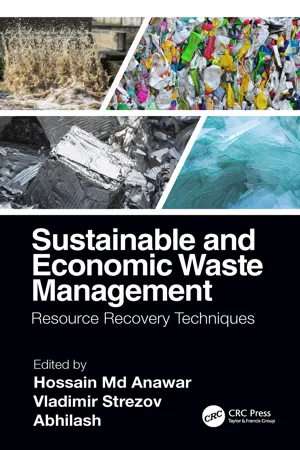
Sustainable and Economic Waste Management
Resource Recovery Techniques
- 316 pages
- English
- ePUB (mobile friendly)
- Available on iOS & Android
Sustainable and Economic Waste Management
Resource Recovery Techniques
About this book
This book compiles research findings directly related to sustainable and economic waste management and resource recovery. Mining wastes and municipal, urban, domestic, industrial and agricultural wastes and effluents—which contain persistent organic contaminants, nanoparticle organic chemicals, nutrients, energy, organic materials, heavy metal, rare earth elements, iron, steel, bauxite, coal and other valuable materials—are significantly responsible for environmental contamination. These low-tenor raw materials, if recycled, can significantly address the demand–supply chain mismatch and process sustainability as a whole while simultaneously decreasing their impacts on human life and biodiversity. This book summarises the large volume of current research in the realm of waste management and resource recovery, which has led to innovation and commercialisation of sustainable and economic waste management for improved environmental safety and improved economics.
Key Features:
-
- Reviews the key research findings related to sustainable and economic resource recovery and waste management techniques
-
- Discusses minimizing waste materials and environmental contaminants with a focus on recovering valuable resources from wastes
-
- Examines the potential uses of mining waste in the re-extraction of metals, provision of fuel for power plants, and as a supply of other valuable materials for utilisation/processing
-
- Presents research on recycling of municipal, urban, domestic, industrial and agricultural wastes and wastewater in the production and recovery of energy, biogas, fertilizers, organic materials and nutrients
-
- Outlines topical research interests resulting in patents and inventions for sustainable and economic waste management techniques and environmental safety
Frequently asked questions
- Essential is ideal for learners and professionals who enjoy exploring a wide range of subjects. Access the Essential Library with 800,000+ trusted titles and best-sellers across business, personal growth, and the humanities. Includes unlimited reading time and Standard Read Aloud voice.
- Complete: Perfect for advanced learners and researchers needing full, unrestricted access. Unlock 1.4M+ books across hundreds of subjects, including academic and specialized titles. The Complete Plan also includes advanced features like Premium Read Aloud and Research Assistant.
Please note we cannot support devices running on iOS 13 and Android 7 or earlier. Learn more about using the app.
Information
1
Pyrometallurgical Process for Recycling of Valuable Materials and Waste Management: Valorisation Applications of Blast Furnace Slags
1.1 Introduction
1.2 Pyrometallurgical Process
(1.1) |
(1.2) |
1.3 The Iron Making Process
Table of contents
- Cover
- Half Title
- Title Page
- Copyright
- Contents
- Preface
- Editors
- Contributors
- 1. Pyrometallurgical Process for Recycling of Valuable Materials and Waste Management: Valorisation Applications of Blast Furnace Slags
- 2. Recovery of Value-Added Materials from Iron Ore Waste and Steel Processing Slags with Zero-Waste Approach and Life Cycle Assessment
- 3. The Reuse and Recycling of Coal Mining Waste with Zero-Waste Approach by Technological Development and Integrated Management for Sustainable Growth and Benefits
- 4. Sustainable and Economically Profitable Reuse of Bauxite Mining Waste with Life Cycle Assessment
- 5. Recycling, Reuse and Treatment Technologies of Mine Water for Environmental Sustainability and Economic Benefit in Mining Operations
- 6. Phosphate Fertilizer Recycling and Recovery from Phosphate Mine and Mining Waste
- 7. Recovery of Resources from REE Mine Tailing and Waste, REE Fertilizer Application and Environmental Effects
- 8. Phytomining of Valuable Metals/Metalloids from Mining Wastes, Tailings and Contaminated Soils
- 9. Revegetation of Energy Crops on Acidic and Alkaline Toxic Metal-Rich Mining Waste and Soil: Carbon Sequestration, Energy Production and Waste Management
- 10. Biogeochemical Processes for Carbonation and Neutralization of Alkaline Mining Waste, Recycling and Waste Management
- 11. Biogeochemical Processes for Pedogenesis and Soil Formation in Mine Tailing and Waste and Plant Growth for Waste Management
- 12. Permanent Landfill and Stabilization for the Remediation of Municipal and Industrial Wastes
- 13. Microbial Fuel Cells to Produce Renewable Energy from Organic Matter-Rich Wastewater and Solid Wastes Focusing on Economic Benefits and Sustainability
- 14. Nutrient Recovery from Food, Industrial and Processing Waste and Effluent Disposal Points in River and Estuary
- 15. Sustainability and Resource Recovery of Waste Handling Services in Commercial Office Environments
- 16. Recovery of Rare Earth Elements from Metallurgical Wastes
- 17. Characteristics and Processing of Copper Refinery Anode Slime
- 18. PGM Recovery from Mine Waste
- Index